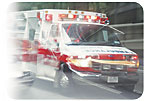
We’ve all seen the TV shows set in hospitals where the patient’s heart monitor is beeping along and all of a sudden it quits and the nurse hollers out “Emergency, the patient has flat lined!” The doctor rushes in, rips back the patient’s gown and grabs a couple of paddles. He yells, “clear” and zaps the patient’s chest and usually the monitor starts beating again, or, to make it more dramatic they have to increase the amount of zap and hit the person again. Most times the heart starts back up and all is well.
Actually, use of an automated external defibrillator (AED) is similar. The training doesn’t have to be that dramatic, but I am sure that having to use one would be quite an experience.
A close call
I know two people who used an AED on a co-worker and are credited with saving the person’s life. The two responders had been trained in CPR and the use of an AED. A co-worker was setting up equipment to do some welding. He felt a shortness of breath and went to sit down. A co-worker saw him collapse to the floor and called for help over a radio. A responder started CPR and the other responder brought the AED. They applied the AED and administered one shock, which started the patient’s heartbeat, at which time an ambulance arrived and EMTs transported the patient to the hospital. The responders and the victim understand the importance of having an AED available and having people trained on the equipment.If an AED is used within three to five minutes of a person suffering heart problems the chances of survival are greatly increased. OSHA estimates that 15 percent of workplace fatalities — more than 400 per year — are caused by sudden cardiac arrest. Of these victims, it is estimated that 160, or 40 percent, could have been saved by defibrillation within five minutes.
How it works
AEDs have become increasingly prevalent in the workplace, public buildings and schools. AEDs are easy to handle; some of the newer models are as small as a child’s lunch box. The operation is simple because the AED walks you through the steps using voice directions. After you turn on the machine it directs you to place the pads on the patient’s chest. The pads (electrodes) usually have a picture on them that shows the correct placement. One pad is placed on the victim’s right upper chest above the nipple and the other is placed on the victim’s left chest just below the nipple.After the pads are in place the AED will monitor the victim’s heart rhythm. If a shock is required, the machine will instruct you to stand clear of the victim and to press the shock button. The shock will be applied and, hopefully, the heart will resume its normal rhythm.
Overcoming the fear of using an AED is one of the obstacles that trainers face. We all have to admit that shocking someone’s heart isn’t an everyday occurrence. That is why good training is so important.
Training tips
Depending on the size of your workforce you will want to identify the number of people you want trained on the use of an AED. If you have first responders, AEDs will be a part of their first-aid and CPR training.General awareness training is a good idea for all employees. Having employees know where the AEDs are located and when they will be needed ensures that anyone can help respond to an emergency. If nothing else, they can call 911 and promptly retrieve the AED.
AEDs can blend into the woodwork after they are placed in the workplace. Like many items you don’t really notice them day to day. To ensure that employees know their location, put out reminders and have employees do periodic checks to make sure the AED is in its proper location.
Keep in mind that you have only three to five minutes to respond to a cardiac emergency and that it may take you one minute to get the AED hooked up and ready.
Don’t think that simply having an AED onsite is your answer to handling cardiac arrest situations. In addition to having the AED you should:
- Train a cross-section of employees in CPR and AED use so that responders represent all shifts and locations.
- Train all personnel to recognize when a cardiac arrest situation has occurred.
- Have employees understand how to communicate the emergency to onsite responders and local emergency responders.
- In addition to CPR/AED training, regularly practice drills with responders to make sure they know the location of the AEDs and are trained to grab the AED on their way to the emergency.
Some general rules
There are a few rules that all AED users need to know:- Don’t apply the AED when a person has a pulse.
- Don’t use the AED on a child under eight years of age unless pediatric attenuated pads, which are purchased separately, are available.
- Shock should not be applied if the patient is laying on a wet surface.
- AEDs are battery operated and need to be maintained according to the manufacturer’s recommendations.
Your safety program will improve with the introduction of an AED program, and company personnel will no doubt respond positively to the effort.